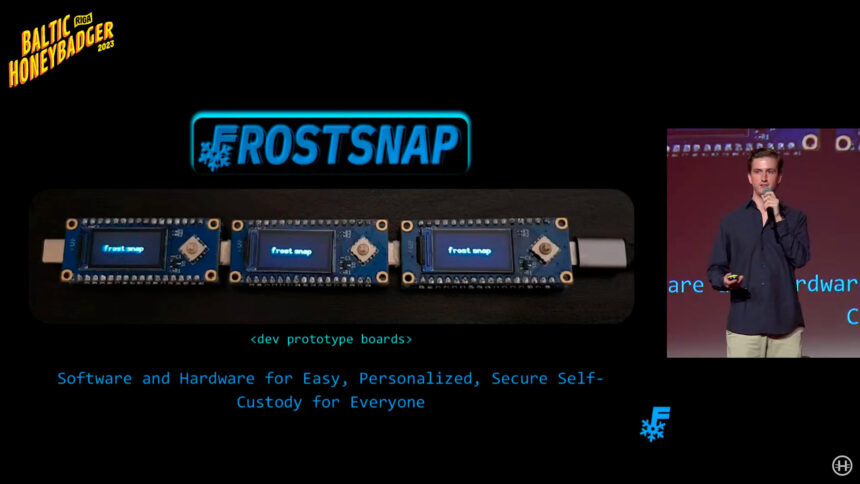Some of the current proposals that’s capturing the eye of builders and customers of Bitcoin is Frost (Versatile Spherical-Optimized Schnorr Threshold), A cryptography protocol that guarantees to rework the best way wherein multisig wallets are managed. Frost opens new potentialities for collaborative custody and inheritance planning.
This advance, which depends on Taproot’s capabilities, might change the foundations of Bitcoin custody dynamics By permitting the rotation of keys, dedicated or not, with out the necessity to transfer funds on the community of cryptoactive.
As such, Frost isn’t an replace of the Bitcoin base protocol, however an innovation in cryptography that’s applied At exterior functions and instruments, akin to Wallets. For that reason, its implementation doesn’t require consensus adjustments within the community or the formalization of official enchancment proposals.
On April 19, 2025, a person identified in X as @W_S_bitcoin shared his enthusiasm on Frost’s implications: «Key rotation multisig off-chain It will likely be a radical change with Frost. Think about having the ability to take away or change a dedicated key with out shifting your funds, and what this implies for collaborative custody and inheritance planning. ”
The publication placed on the desk a technical resolution that has been taking time and now appears near changing into a actuality, because of tasks akin to Frostsnap. Nonetheless, and though it might be near materializing, there aren’t any particular dates for its launch.
In response to Frostnap from his X account, the rotation of keys occupies “a outstanding place in our record of pending duties as soon as we now have completed sharpening the fundamental points of our Pockets and we now have Frostsnap in your arms.”
What’s Frost in Bitcoin?
Frost, which implies Versatile Spherical-Optimized Schnorr ThresholdIt’s a protocol that takes benefit of Schnorr corporations and Taproot addresses, two enhancements launched in Bitcoin in recent times, to optimize scheme administration multisig. This protocol was proposed by researchers Chelsea Komlo, Ian Goldberg and Douglas Stebila in 2020.
In a nutshell, it permits a gaggle of contributors to handle a shared Pockets in order that, even when one of many personal keys is compromised, This may be changed with out the necessity for transactions within the Bitcoin community or generate a brand new full pockets from scratch.
On the one hand, this reduces the prices related to community commissions; On the opposite, it improves privateness, because the transactions generated with Frost are seen within the chain as in the event that they have been distinctive, indistinguishable signatures of a standard transaction within the Mempool.
The potential of this expertise didn’t go unnoticed by Frostsnap, a venture that’s creating particular units to implement Frost.
In response to the remark of @W_S_Bitcoin, the Frostsnap workforce expressed in X his expectation that “the day comes once we should not have to maneuver a complete Pockets to a brand new one simply to alter a signatory.”
As cryptootics reported, Frostsnap works on options that enable customers to handle shared keys between a number of units, making certain that transactions are safer and extra personal. Nobody can distinguish that Bitcoin is protected by a scheme multisigThey guarantee Frostsnap, highlighting how Taproot hides the collaborative nature of operations.
Technically talking, multiphmas generated with this protocol They appear to be any Taproot transaction (BC1P) on the Bitcoin Community.
From a technical viewpoint, Frost represents a major advance within the subject of cryptography utilized to the Bitcoin Community. This protocol permits the normal schemes of threshold signatures to be applied (threshold signatures) of sort «N-de-M», the place solely a sub-conjunction of contributors must signal to authorize a transaction.
Benefits and challenges of the Frost protocol in Bitcoin
This course of is carried out fully exterior the chain, via communication rounds between the contributors, which eliminates the necessity to expose the small print of the scheme multisig Within the crimson bitcoin.
As well as, when integrating with Taproot, the ensuing transactions are cheaper by way of area within the chain and extra personal, since they don’t reveal the complexity of the custody association.
Nonetheless, Frost’s implementation isn’t exempt from challenges. The identical technical supply signifies that the complexity of its improvement is a crucial barrier: guaranteeing a secure and dependable implementation on completely different platforms and programming languages might be key to its mass adoption.
Regardless of these obstacles, the official draft of the protocol, accessible on the IETF and revealed in June 2024, reveals that Frost It’s in a complicated stage of de improvement and technical definitionsuggesting that its sensible use might be simply across the nook.
For Bitcoin customers, Frost’s implications are attention-grabbing. In a context of collaborative custody, the potential for rotating keys with out shifting funds reduces the dangers related to the loss or dedication of a key.
When it comes to inheritance, it permits to design schemes the place the beneficiaries can entry the funds with out the necessity for onerous or public transactions within the Bitcoin Community, whereas modifying the insurance policies of entry to those inheritances in case it’s vital via the rotation of keys.
As well as, the privateness supplied by hiding nature multisig From transactions, vigilance efforts by exterior actors might hinder a vital facet in a context the place the traceability of transactions stays a problem mentioned.









